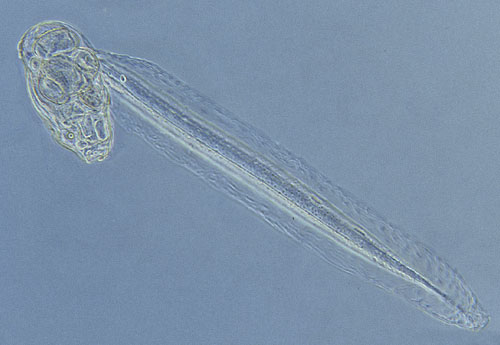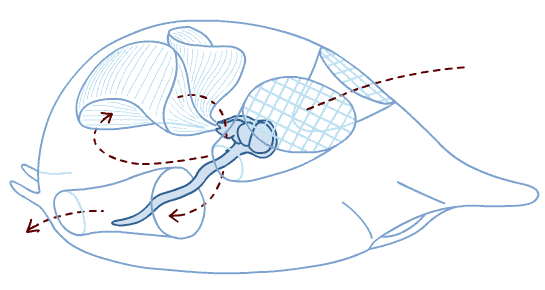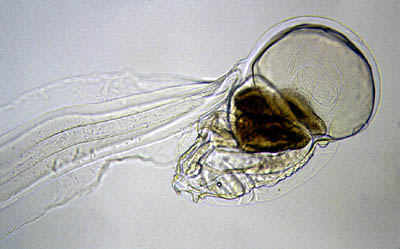Oikopleura's
fishing house
- by Wim van Egmond, The Netherlands
|
| |
When I was
examining some marine water under a stereo microscope I
suddenly saw something I had always been intrigued by. It
was a larvacean called Oikopleura. Larvaceans are
primitive chordates related to tunicates.
They look like tunicate larvae but retain this larval
shape when they become adult. |
|
| |

Oikopleura
without its housing
|
|
| |
|
|
| |
In
fact I did not see what I wanted to see. The most
intriguing bit about this larvacean is its housing. And
this housing isn't visible since it is completely
transparent. But I detected the housing since I saw the
small larvacean wiggling its tail to create a water
current within this housing. Oikopleura is a
tunicate, a primitive chordate, and its house is a very
complex fishing device. It is very difficult to study
since it's very delicate. If you try to transfer it onto
a glass slide for examination under the compound
microscope it will certainly be destroyed. But I thought
it would be interesting to try and observe it better. A
watch glass would make it easier than the plastic
container it was in now. I took a pipette with a rubber
sucker and attached the rubber sucker to the wrong end.
Now I had a pipette with a very wide opening, so I tried
to suck up the delicate organism and it worked. To
prevent damaging it I had already put some water in the
watch glass.
It worked.
The larvacean was still alive and its house was intact.
But it was impossible to photograph since it was not
visible at all. The only way to see the shape of it was
to follow the water current. I could see two fine nets
because they were full of tiny particles. The fishing net
is so fine meshed that scientists have used it to trap
and study the tiniest marine creatures. The house is
quite big compared to the small inhabitant.
|
| |

A drawing of Oikopleura in its fishing house.
This drawing
was based on the work of Dr. Lohmann, a German
planktologist who discovered the feeding apparatus. The
red line shows the water flow (through one entrance)
created by the undulating tail of the larvacean. Large
particles are blocked by protective grids. The filters on
the left, filter tiny organisms from the water which are
then passed to the mouth. The filters are so fine-meshed
that they can filter out particles as small as 1/1000 of
a millimeter. Finer than any plankton net. Dr. Lohmann
was able to discover many unknown tiny life forms
(flagellates etc.) by examining these filters.
The opening
at the front (bottom right) of the house is an emergency
exit!
|
| |
Although I
knew it would be impossible I tried to transfer the
creature to a microscope slide. And indeed it did not
work. The house was immediately destroyed into a
shapeless mass. I made a series of pictures of the
homeless Oikopleura and I tried to reconstruct its
housing in a drawing so you'll get an idea. I
do think it must be possible to make pictures of the
whole device. It has to be done in a very small aquarium
with illumination from the back (like darkfield
illumination). By carefully adjusting the position of the
lamp the housing should light up. A strong macro lens
that enables a magnification of 3 to 1 should be enough.
Plenty of specimens should be available. Larvaceans
rebuild their house every day. If you give them time it
should be possible. But I did not succeed. I only found a
few larvaceans, but was already pleased that I made this
observation. And it is not that bad that there are still
many challenges left in microscopy.
|
| |
More about
the anatomy of larvaceans, and some of their relatives
like the salps can be found in the article Tunicates
extraordinaire: Salps, Larvaceans by
Jean-Marie Cavanihac. |

A close up of the head of Oikopleura, the large
sphere is its ovary.
|
Comments to the
authors Wim van Egmond are
welcomed.
More articles about
microscopic organisms can be found on Wim's HOME PAGE
Microscopy UK Front
Page
Micscape Magazine
Article Library
All photographs ©
Wim van Egmond
Published in the
January 2001 edition of Micscape Magazine.
Please report any
Web problems or offer general comments to the Micscape
Editor,
via the contact on current Micscape Index.
Micscape is the
on-line monthly magazine of the Microscopy UK web
site at Microscopy-UK
WIDTH=1
© Onview.net Ltd, Microscopy-UK, and all contributors 1995 onwards. All rights
reserved. Main site is at www.microscopy-uk.org.uk with full mirror at www.microscopy-uk.net.


